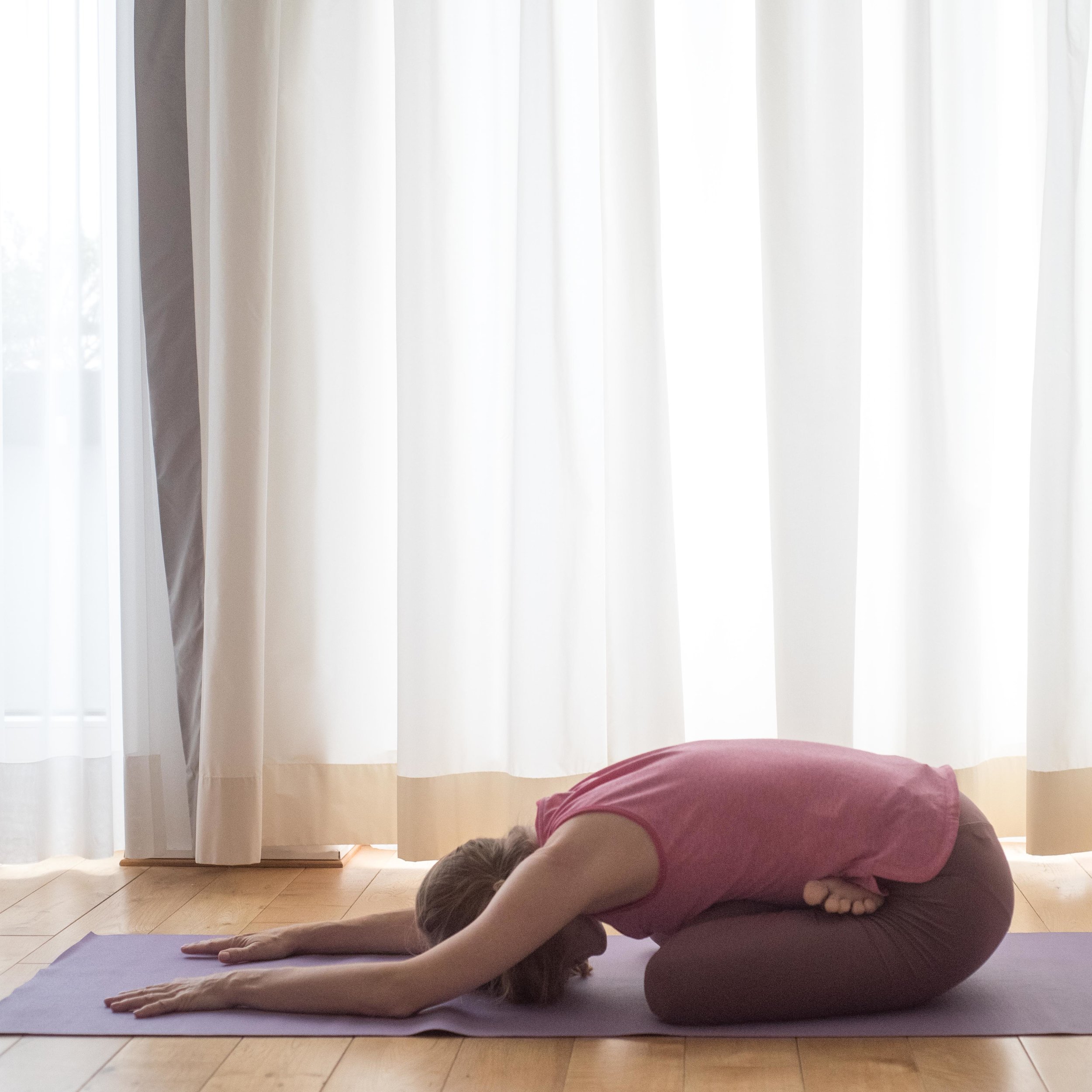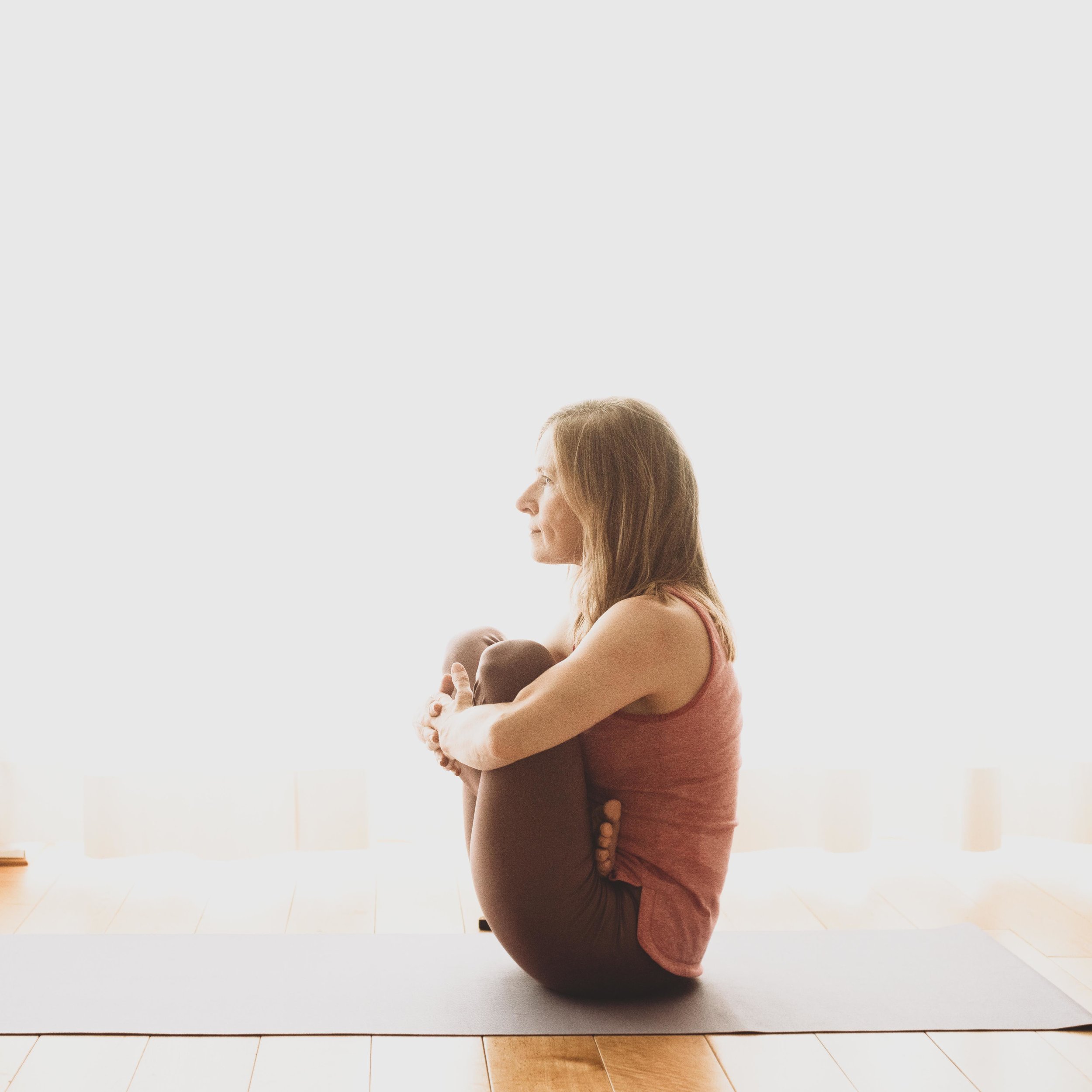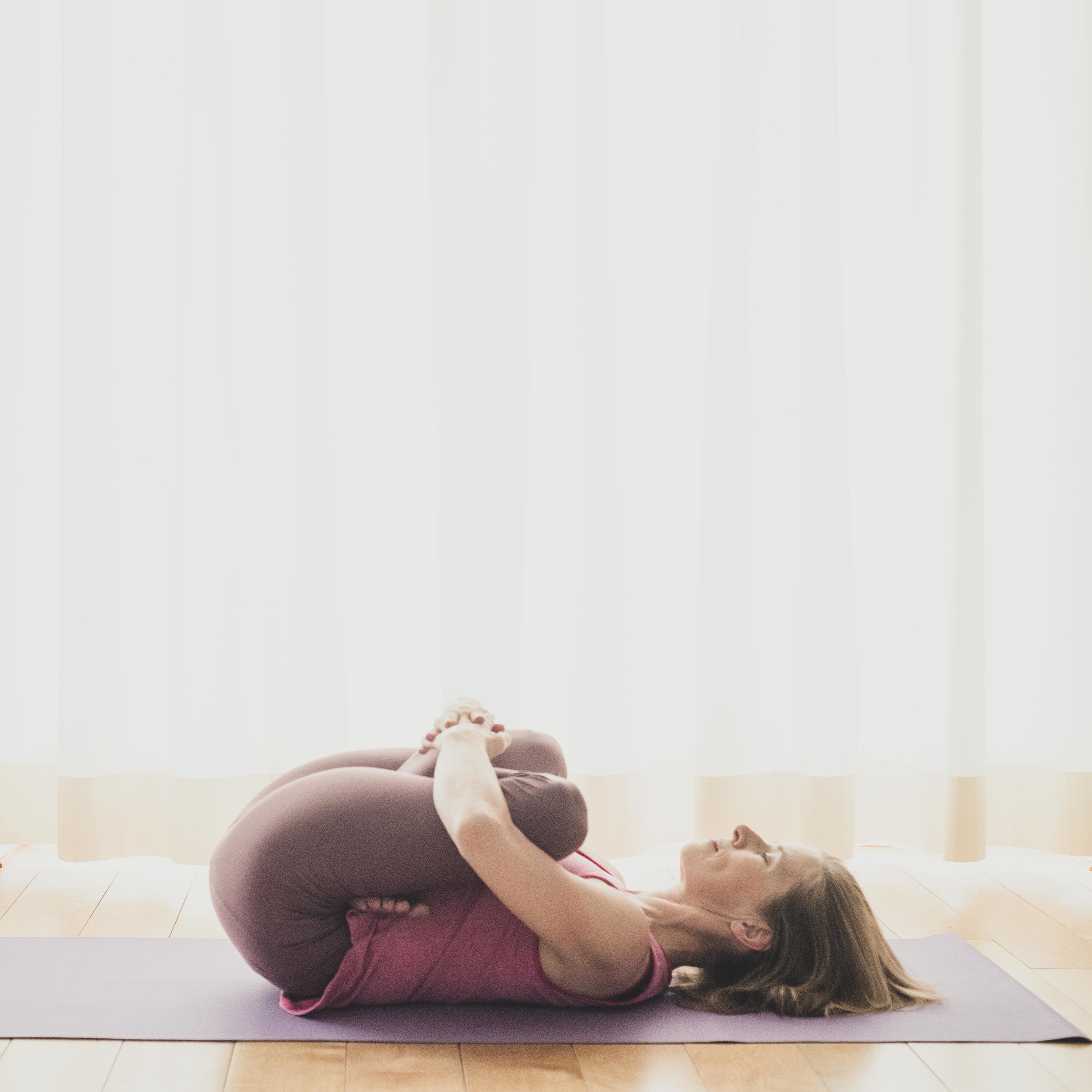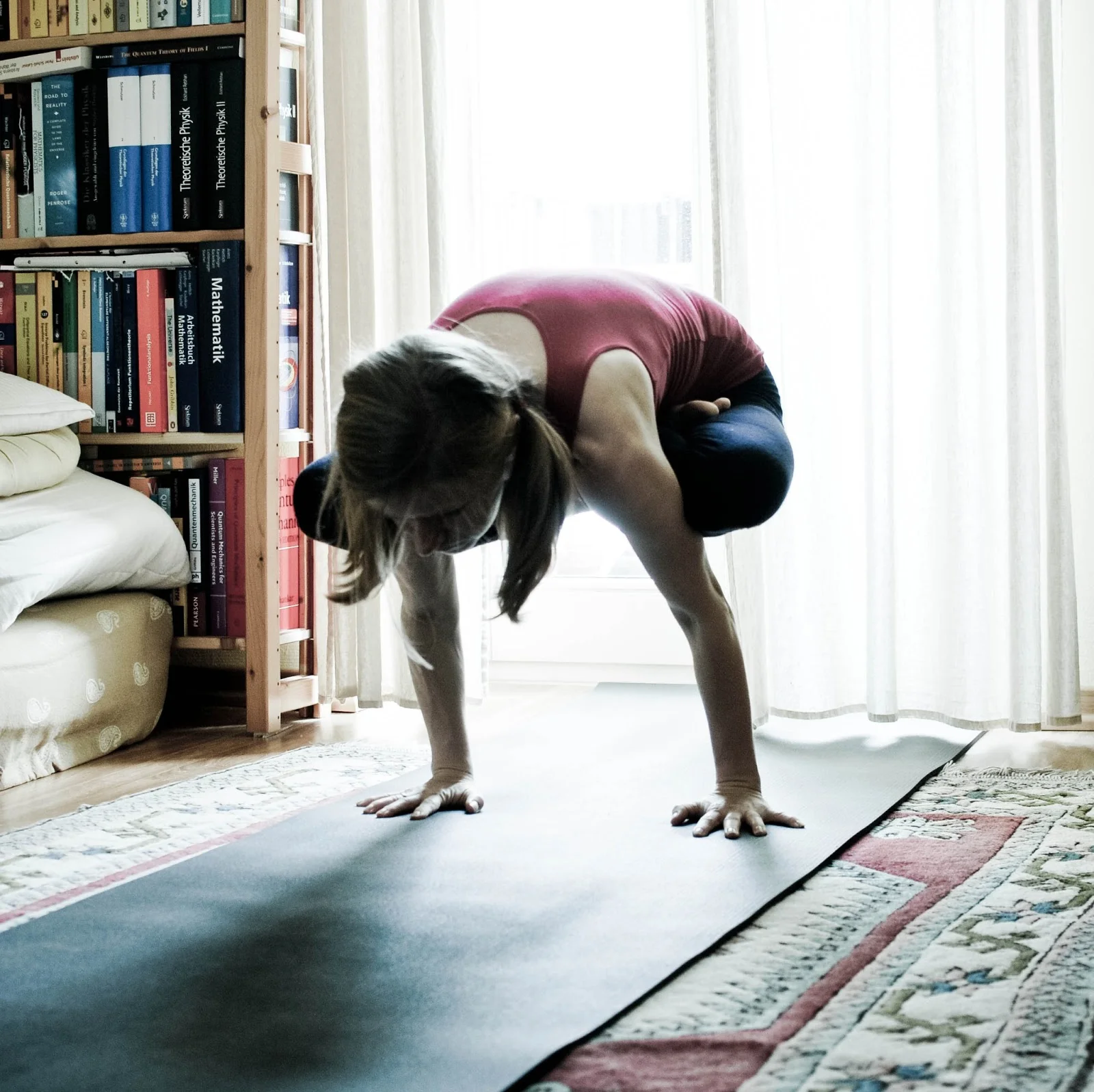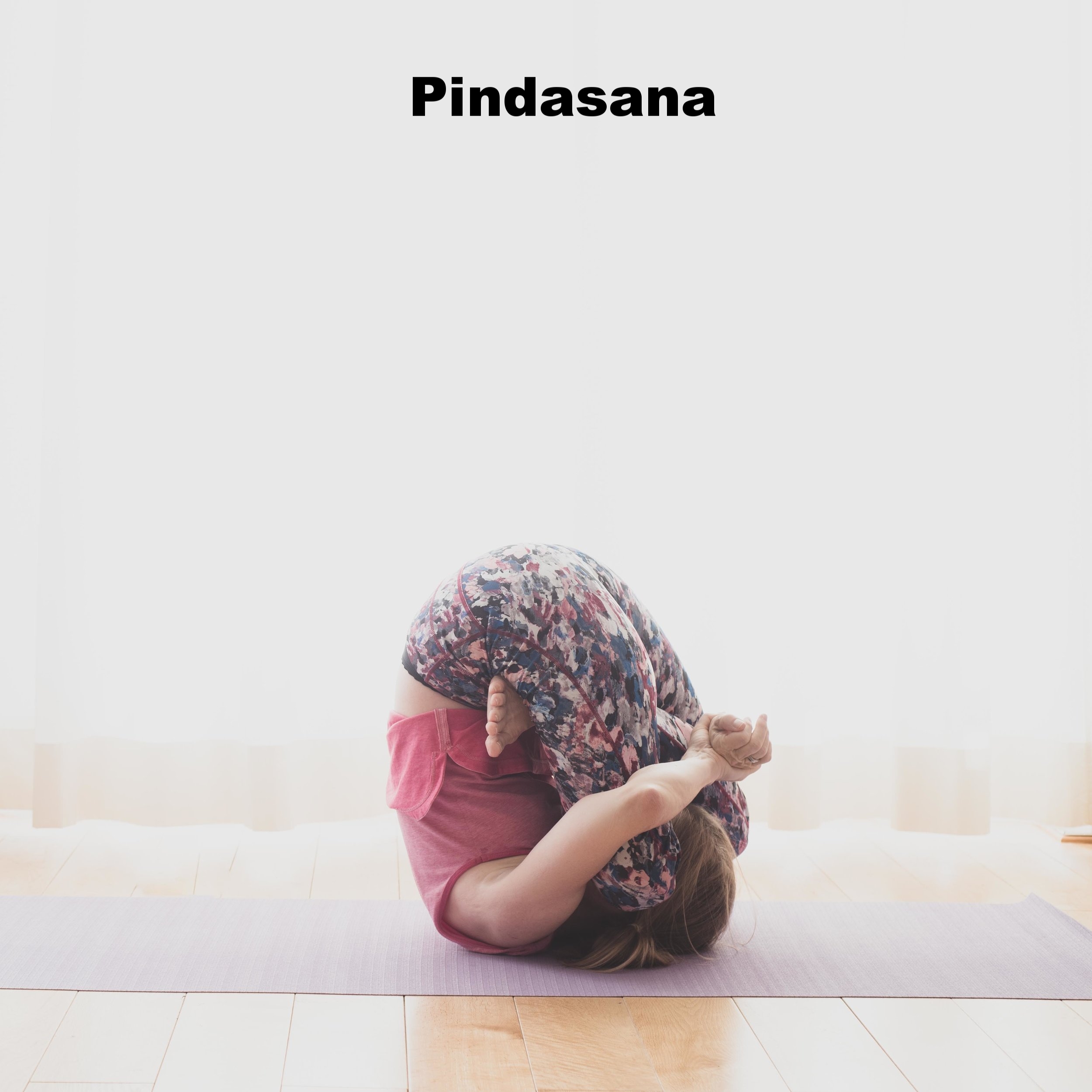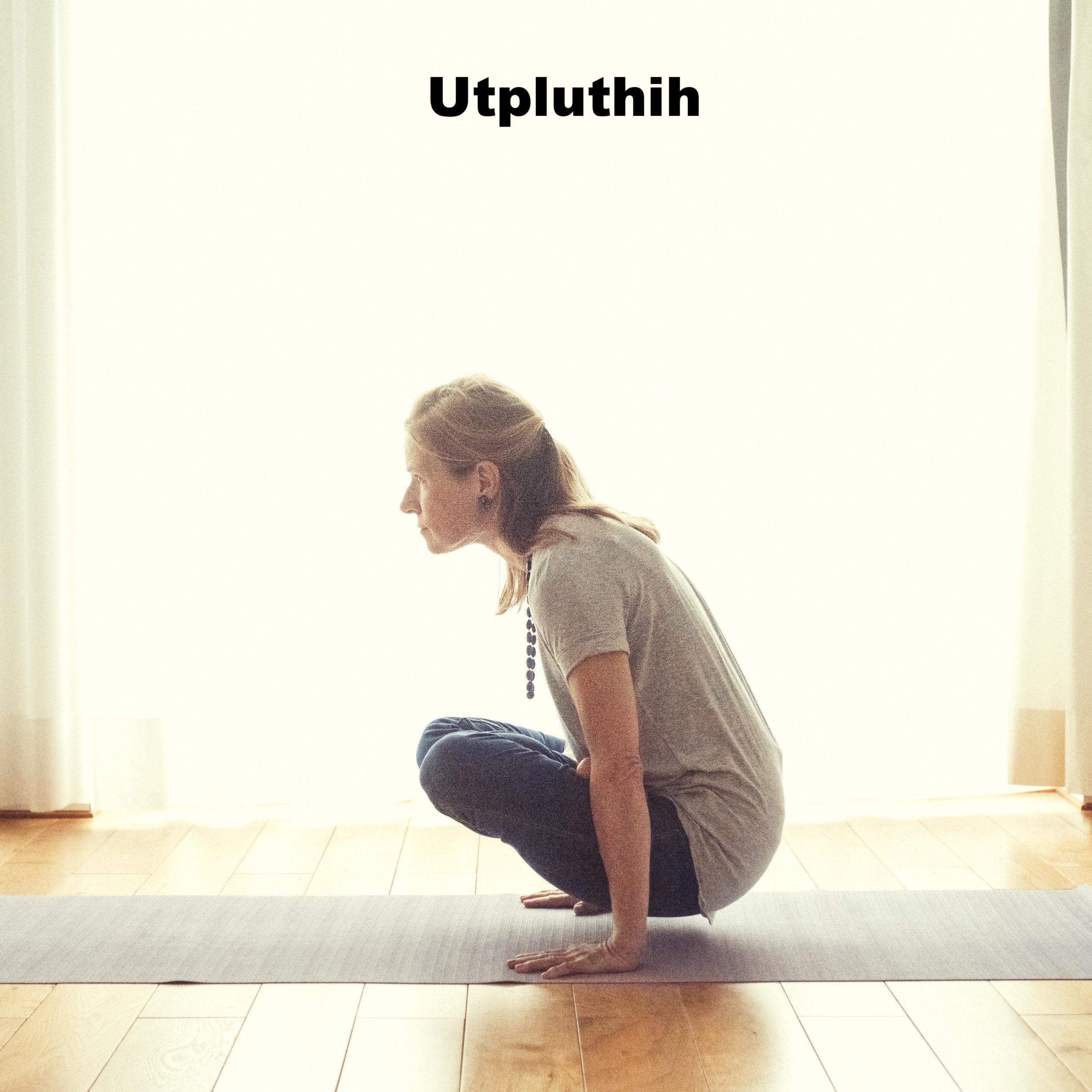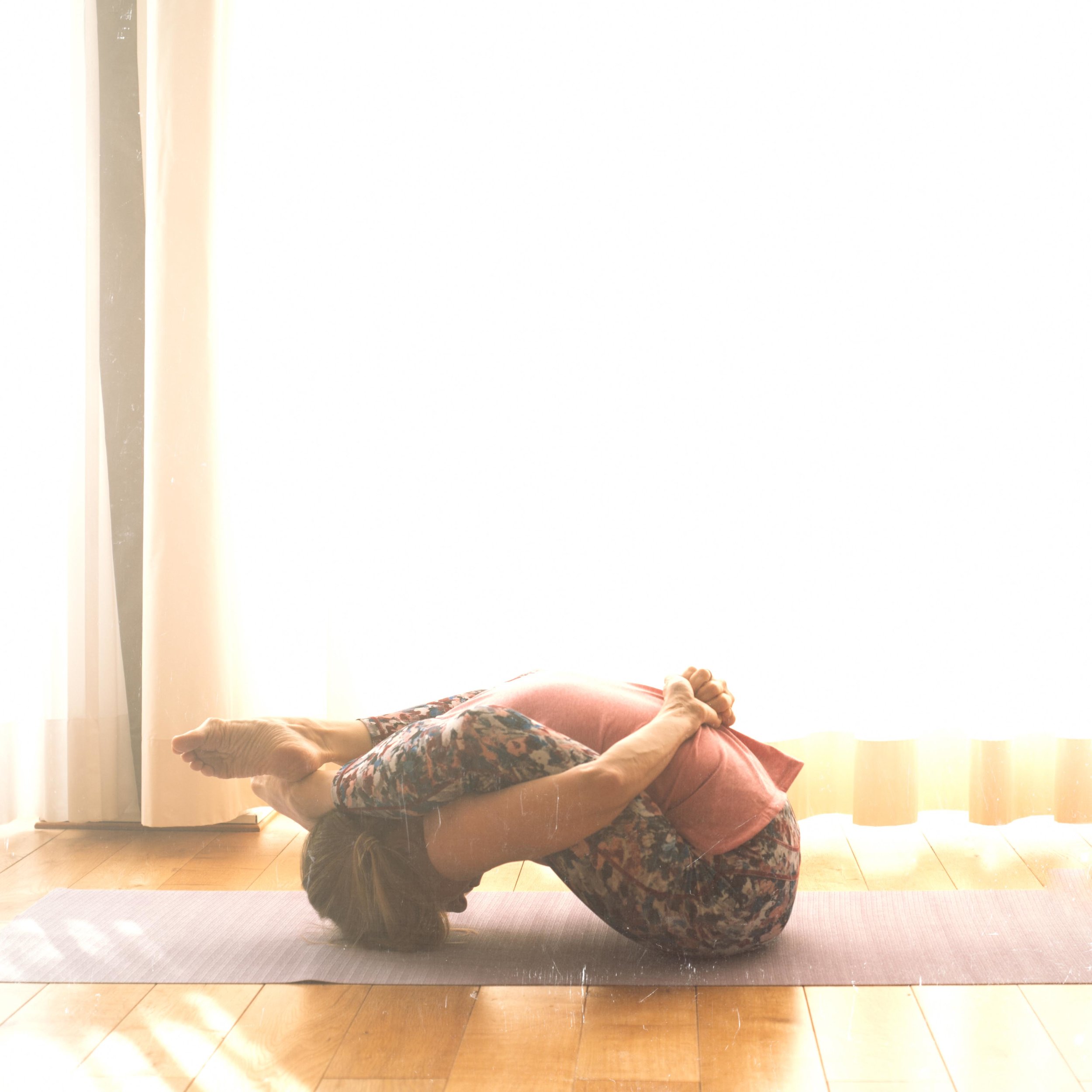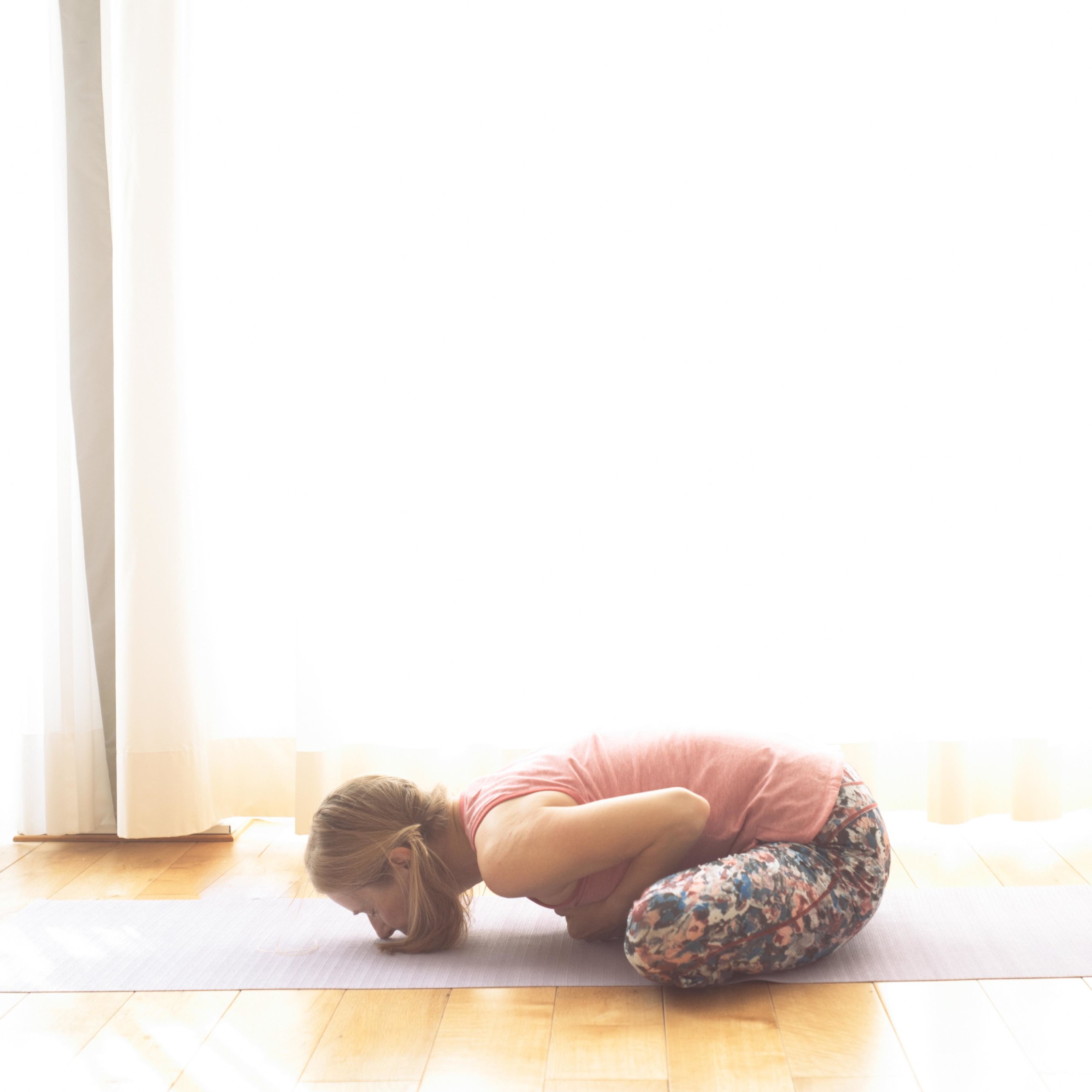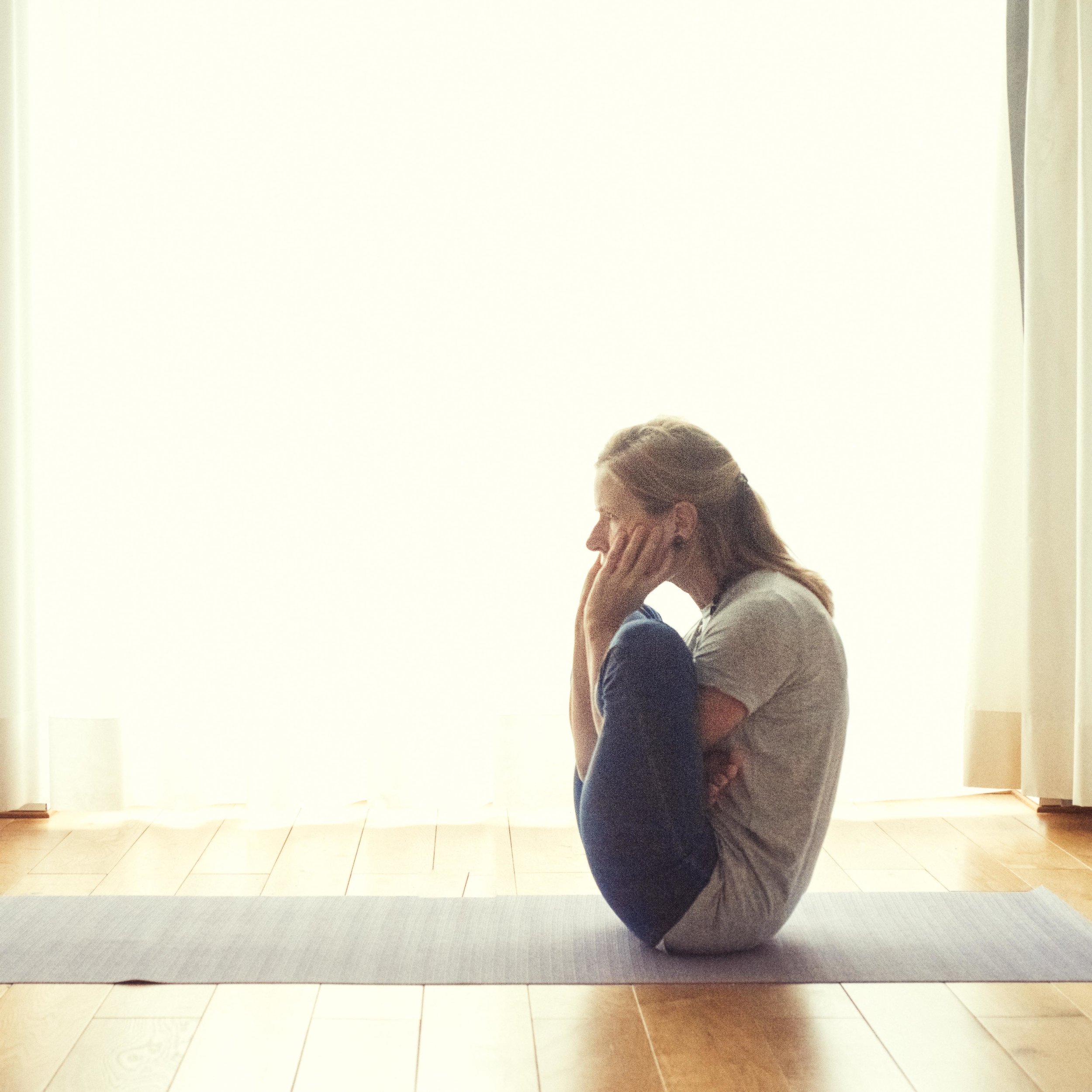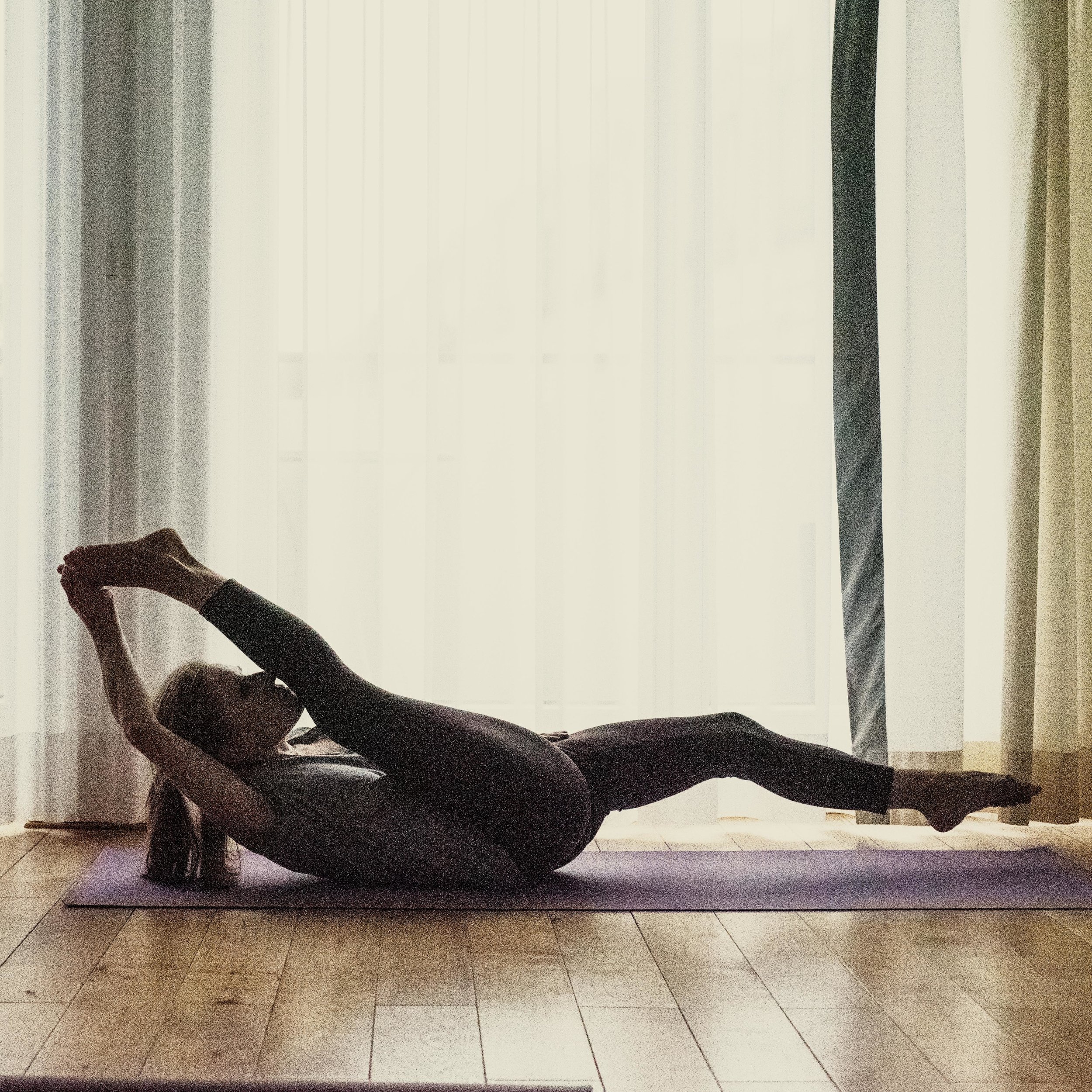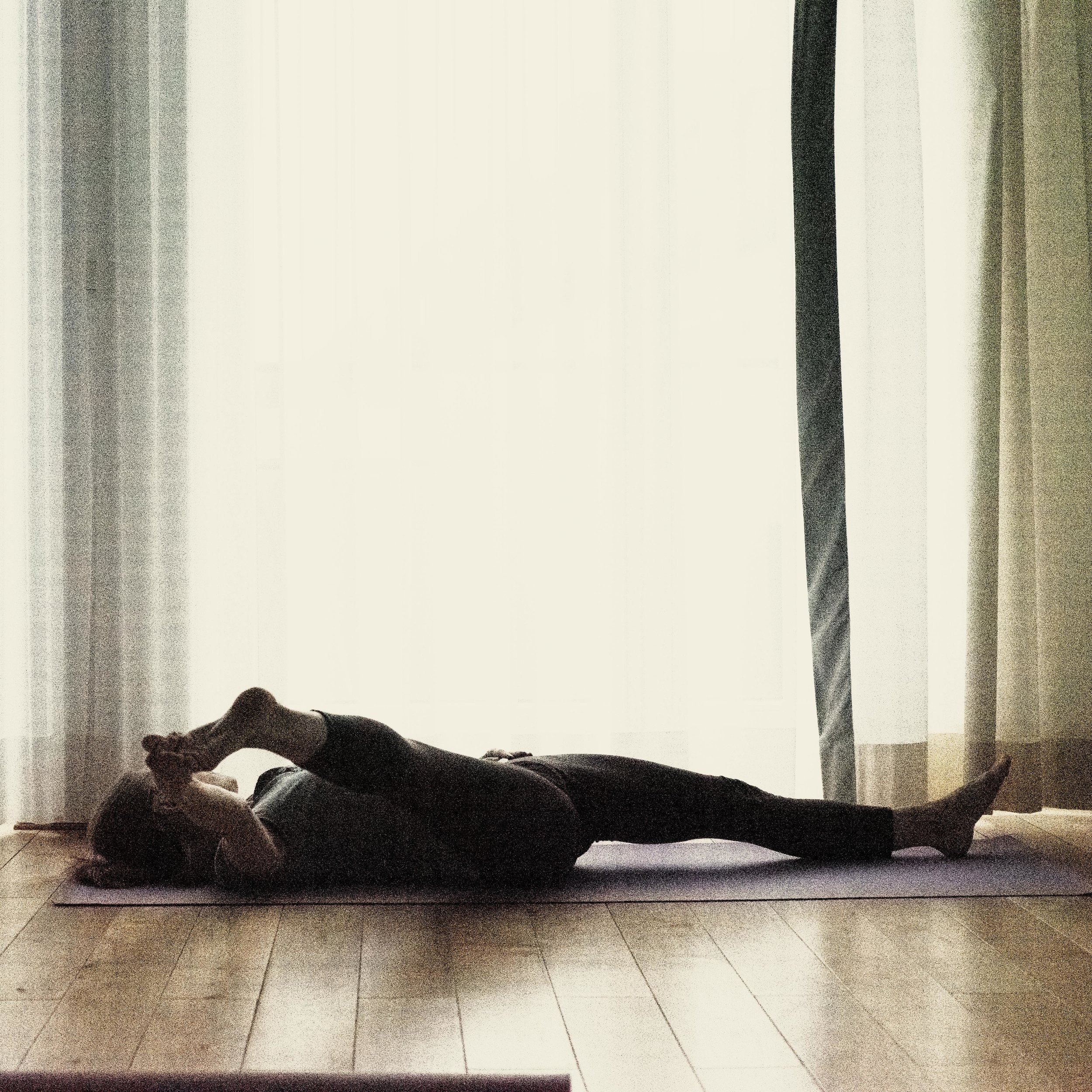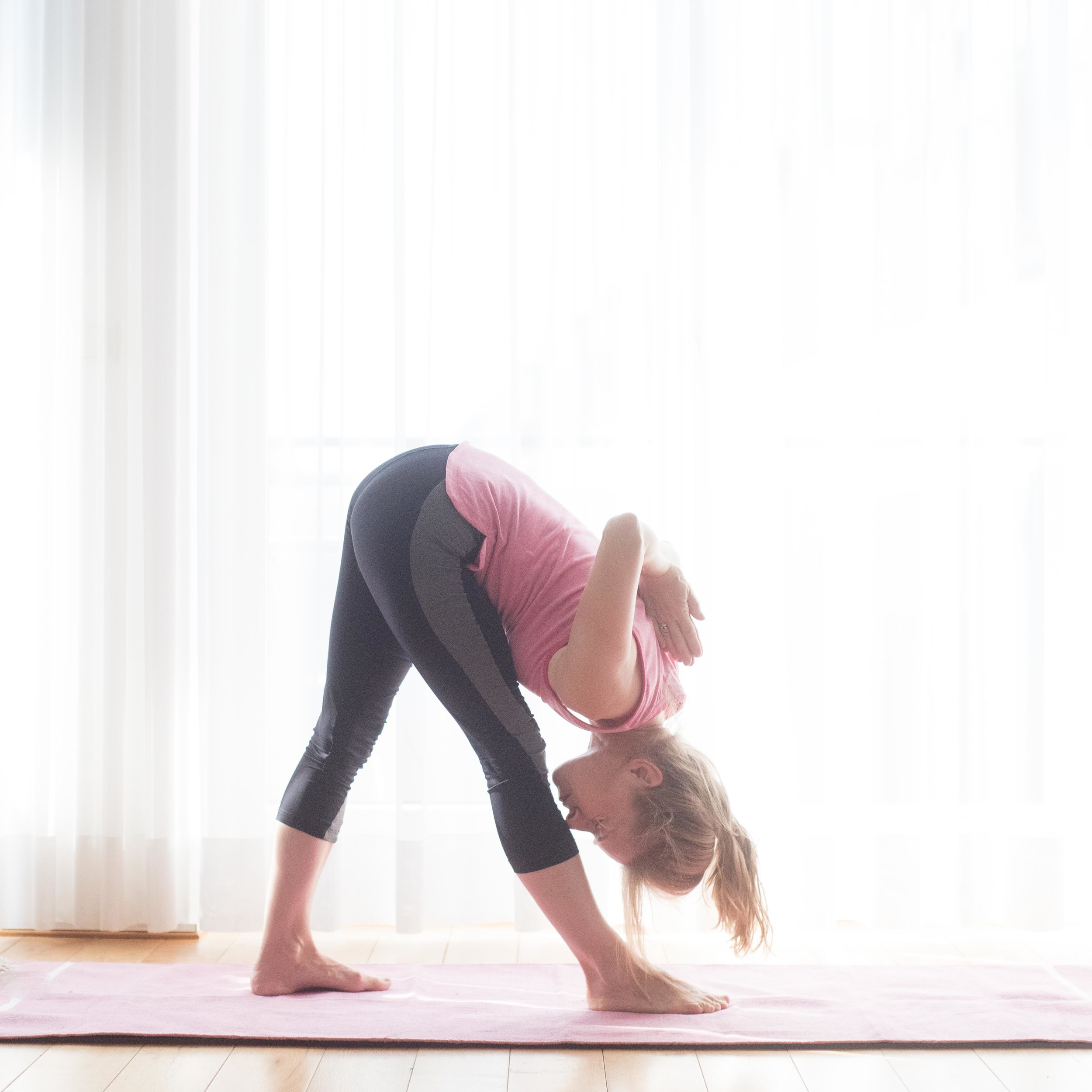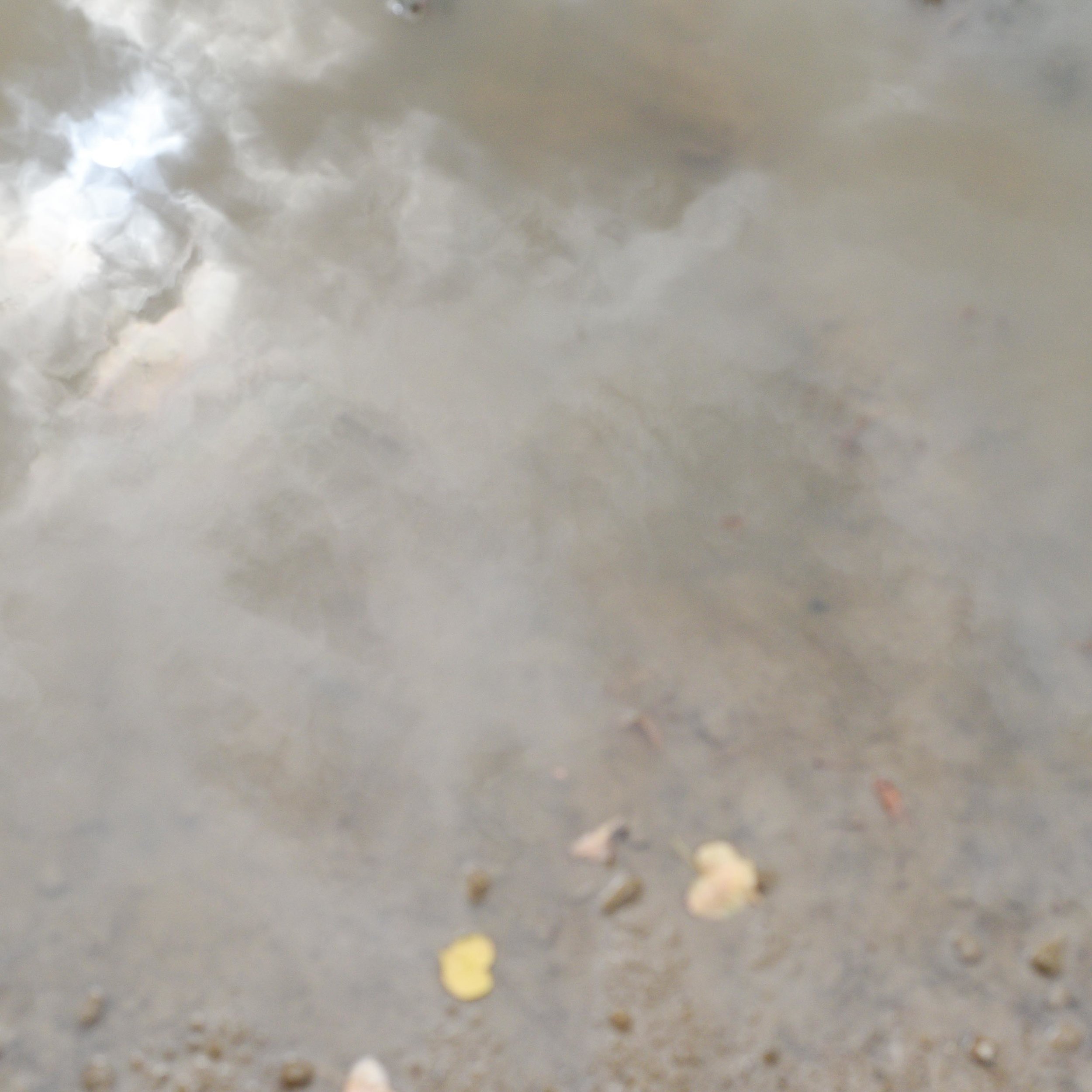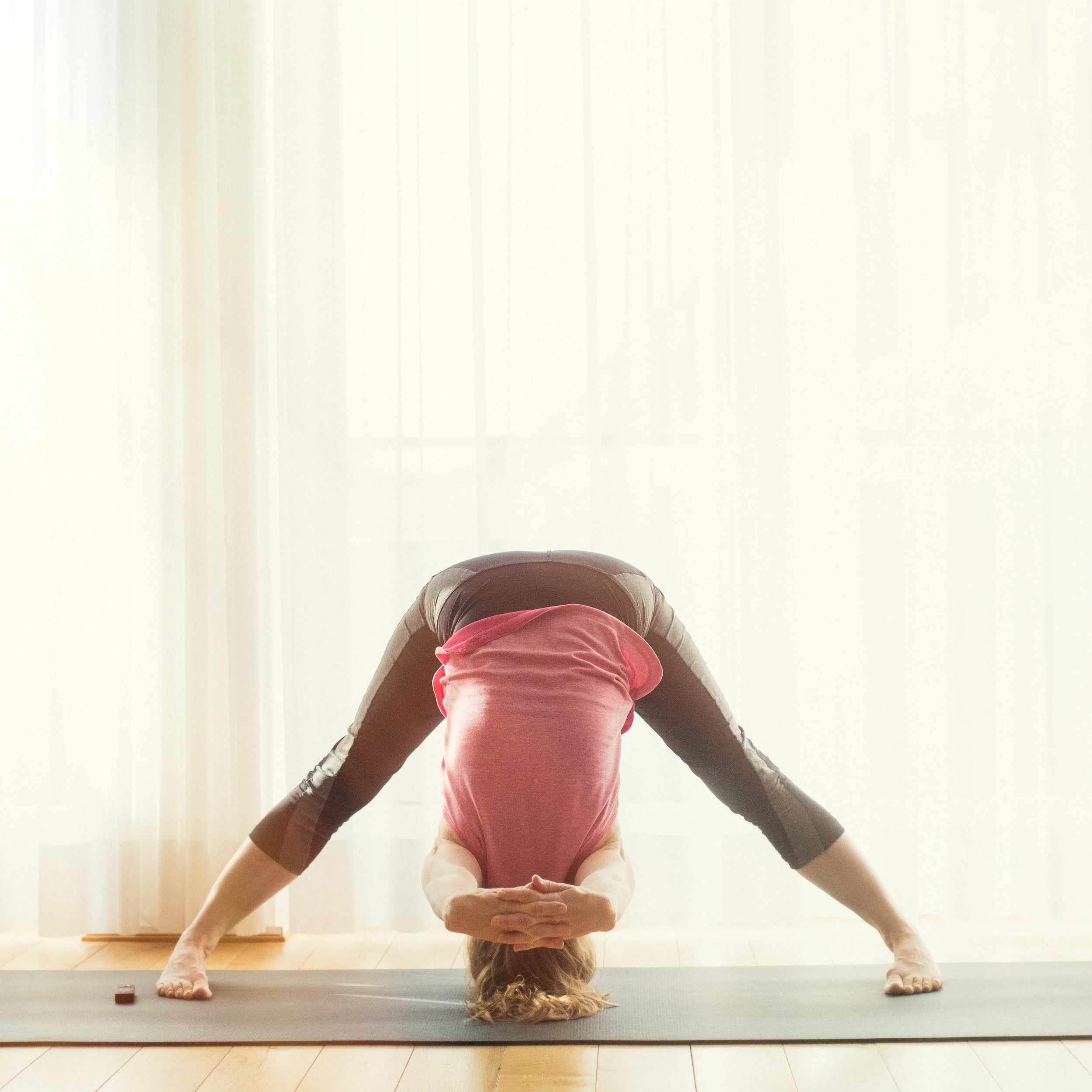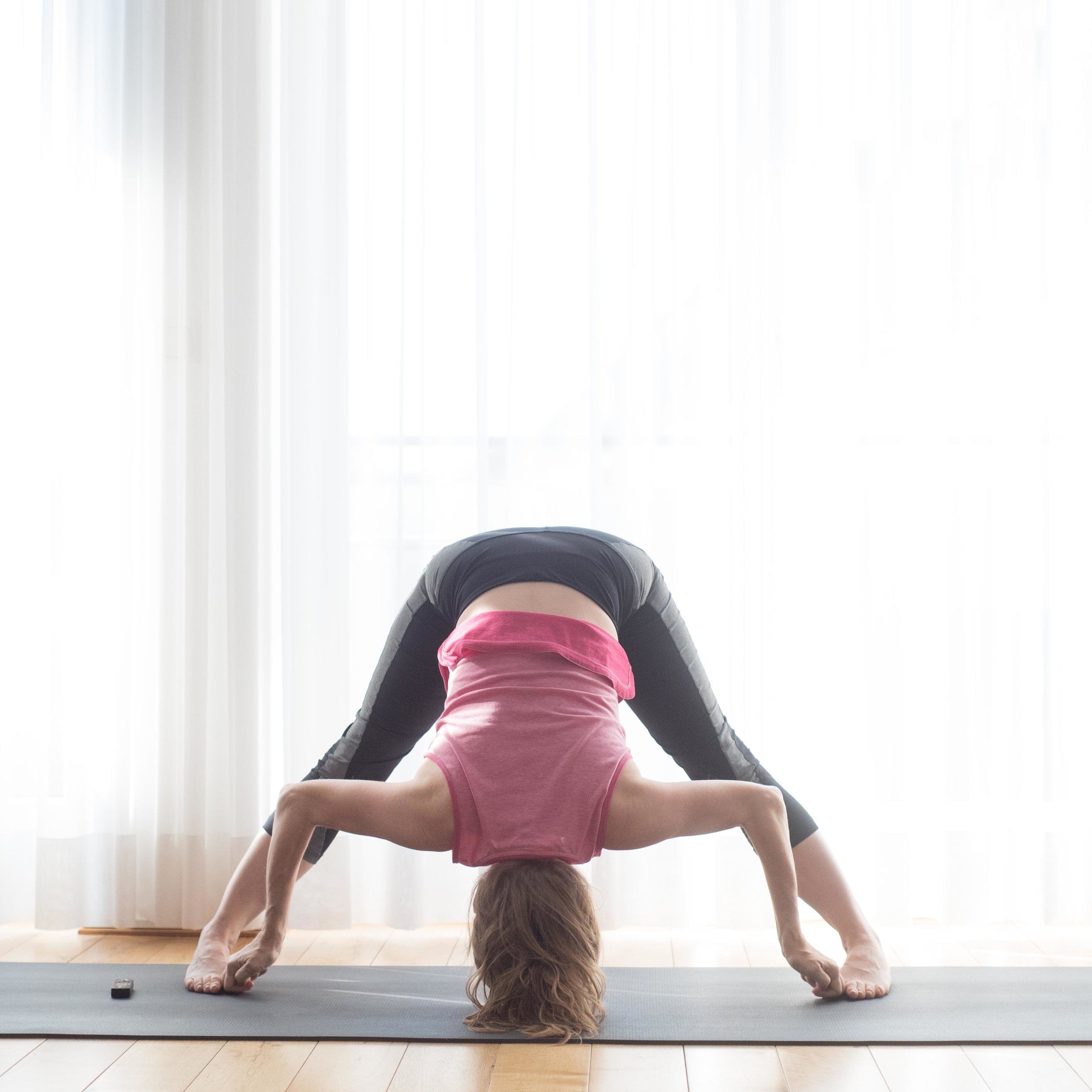Bye Bye 2018
Obstacles on the path
This morning I got up at 7 am. The alarm clock woke me up. It was so cold in the hotel room. Even after the shower and the hot coffee I felt icy. I couldn’t convince myself to put on yoga clothes. They are all designed for hot yoga schools and hot mornings in India. It became warmer and warmer during the day. It was too late for my practice.
One of the main reasons why I skip a yoga practice is the cold. It’s too cold in here I often think. I cannot stretch. I shiver. I also fear to injure myself when it’s so cold. In addition the body is stiff then.
I consider to buy clothes that might keep me warm when I practice on cold days. Not all asanas might be possible with thick and warm clothes, but I could at least do some not so intensive stretches and strength training..
Utkatasana
The next asana of the standing sequence of Ashtanga yoga is utkatasana. It’s more or less a strength exercise for the legs and the abdomen. This pose can invite to do squats. I focus on the exit. In order to get stronger I hold the poses shown in the pictures as long as I can. It’s exhausting. The muscle must burn if one wants to get stronger. If nothing is felt, nothing happens.
All poses can be done sloppily. With time I understood why I exercise a certain asana. It allowed me to work especially on these aspects. For me utkatasana is a strength exercise, especially the vinyasa, the exit.
Yesterday I didn’t practice. I was too busy with other activities. At least I accomplished something. In addition I was slightly overstretched. I cursed. The right side of my hips hurt. Not all the time, but a tiny wrong movement and I realized that I had done too much. The front side of the body hurt when I walked it hurt when I stood. The difficulties with stretching are that you feel the next day when you did too much and not when you’re stretching. Overnight my body repaired the damage. I’m 99 % OK again. Today no splits! I must realize that I got older. My body needs more time to recover from intensive exercises. Daily practice becomes more and more important. To practice safely, without injuries is goal #1.
Padmasana variations
Quick summary:
Half lotus pose gets introduced in the standing asanas (ardha baddha padmottanasana). In the middle part of primary come 2 poses with full lotus pose. Garbha pindasana has a dynamic phase and a static phase. The pose ends with Kukkutasana which has also a balancing aspect.
My topic these days is didactic. How can I learn an asana faster and safer. What are the tiny steps towards the end form. Do I need more flexibility or strength? Have I understood the technique to perform an asana? These are the questions. It makes sense to move from easier variations to more difficult ones. Easier variations always exist. Another reason for knowing easier variations is that it can happen that an asana is no more possible because of injuries. Instead of omitting an important asana, easier variation can do the job.
First I analyse the asana: Garbha pindasana requires to do lotus pose. It’s also a forward bending asana.
This is exactly what I did. I put my legs in lotus pose and bent forward. Gravity helps. When bending forward it’s important to stretch first. It helps to create length. The movement starts from the hips.
The second variations uses the arms as a leverage. This pose should be applied with much care. The shoulders are very sensitive joints.
The third variation is usually recommended in classes as an interim step toward garbha pindasana. It has a balancing aspect. In order to hold the pose it’s good advice to engage the hip muscles. The arms shall not do all the work.
The forth pictures is the most relaxing one. Lying on the back is always relaxing. With the arms one can support the movement. Finally a pose shall feel good.
Experimenting with variations deepens the understanding of the asanas.
It’s Tuesday today. I focus on back bending.
Padmasana and the Ashtanga yoga series
Each of the four Ashtanga yoga series has in the middle part an asana sequence with padmasana.
Series: Garbha pindasana and kukkutasana
Series: Supta vajrasana (a static part and a dynamic part)
Series: Kukkutasana A, B and C (three different vinyasas)
Series: Punga Kukkutasana (very demanding)
My light bulb moment yesterday:
In the first series we have padmasana combined with forward bending.
In the second series we have padmasana combined with back banding.
In the third series we have padmasana combined with arm balancing.
In the forth series we have padmasana combined with arm balancing and twisting.
The combination padmasana with inversion is covered in the closing sequence. This is perfect!
With this analyses it’s possible to find similar variations that might be a bit easier at first than the given asana. One can approach any asana slowly, step by step.
Many yoginis struggle with garbha pindasana. When a yogini is able to sit comfortably in lotus pose the pose is almost mastered. The rest is technique. I’ll write about this later.
The asana of the second series requires usually help from another person. I had a teacher who allowed other yoginis to adjust. Another teacher didn’t like this at all. Not many fellow yoginis could adjust in a way that the adjustment was a support. At home one has no teacher at all. So what to do. I used to sit in padmasana, arms crossed behind the back. I held my toes and took 5 deep breaths. That was it. With my new analysis I’d do an asana with padmasana combined with back bending. There are a lot of variations.
Urdhva kukkutasana is an arm balance asana. The differences between A, B and C refer to the vinyasas. The not dynamic part is always the same. In order to move into this asana I did headstand with the hands flat on the floor. Then I crossed the legs into padmasana and lowered them. When they touched the arms I lifted the body, I stretched my arms. I lost so much strength that I’m not able to lift my body these days. That’s why I show above a picture from 2013.
I never practiced punga kukkutasana. Once I tried it, but I’m miles away from this twist. Easier variation can be integrated in the first series, so that the body gets prepared for the future.
In one of my next pose I’ll show variations of asanas with padmasana……..there are a lot variations.
I’m ready now for primary.
My five favorite props
My 5 favorite props are:
The wall
The wheel
The blocks
The strap
The timer
Today I practiced second series and I used all five props.
The wheel and the wall supported back bending. The timer, the strap and the blocks supported me when I worked on the splits.
Props are a huge taboo in the Ashtanga yoga community. In a traditional Ashtanga yoga class no props are allowed. I once used a block in order to sit on it when I practiced pashasana. I always rolled out of the pose when my feet were flat on the floor. The block should prevent this. In a fracture of a second the teacher was next to me and took away this block. He was not amused, not at all. I never used any block again in that yoga class.
I remember an other yoga class where props were introduced and allowed. It was a huge support. Nevertheless I also realized that there was much more distraction in that yoga room. Yoginis ran around to get props, conversations started and so on……
When a room is full of students it’s impossible to use any props. I see this, too. This would mean CHAOS.
My view: What helps to learn an asana is allowed. Props can accelerate the learning process. Yes, they distract. They interrupt the flow. I think it’s good to think of them as a temporarily support. It might be good to try an asana with and without props.
My practice:
My body allows me to do surya namaskara B. I get out of breath. Fine, this has been so years ago, too. I become stronger. Every day I think a miracle happened.
Today we’re invited to a party. I postponed my breakfast so that I can eat all my meals within a time frame of 8 hours. I feel so much better when I have my main meal at lunch time. This is not always possible. No, I won’t sacrifice every joy and party. I don’t want to live withdrawn only because my life style differs often from the one of my peers, friends and whoever. As always I try to make the best out of it. I love to meet people. I love to be invited and to celebrate birthdays. Flexibility means much more than taking the leg behind the head.
Tomorrow I’ll write about padmasana and the variations. I had a light bulb moment this morning.
Padmasana and variations
Bit by bit I go through the asanas of the Ashtanga yoga series. I show connections that I found out. Having an overview can be motivating.
Lotus pose gets introduced in the standing sequence of Ashtanga yoga. Ardha baddha padmottanasana is an asana with half lotus. In the middle part of primary come three asana that require the skill of padmasana. It’s garbha pindasana (2 parts) and kukkutasana. All these asanas are challnging. Other variations of padmasana come in the closing sequence. There are 6 asanas with legs folded into padmasana. Also the other 3 series of Ashtanga yoga have one asana minimum with lotus pose in their middle part. With each series it gets more demanding.
Each time when practicing one of the Ashtanga yoga series one practices at least seven asanas with legs folded in padmasana. In addition padmasana in it’s simple form is the best seat for pranayama and meditation.
I think this can be enough motivation to spend some time in learning this classic pose. It’s possible to integrate padmasana in the daily life. Right now for instance I sit here in lotus pose (left leg first…. hahaha). Each time when sitting anywhere one can exercise this pose and prolong how long one sits in that pose. Any knee discomfort is a message from the body to get out of the pose.
When padmasana is mastered a key asanas is mastered. Many asanas to come build on that skill.
Of course there are much more asanas with padmasana that are no part of the Ashtanga yoga series. I’ll show some in blog posts to come.
At the end of this post I want to tell a story. I reflected for a long time if I shall write about it, because it’s not my story. Someone, who experienced it told it. It shall be a warning. Injuries are a taboo in the community, but I think one shall talk about it, too.
A yogi went to a workshop. One of the VIP masters offered a workshop in Berlin. Like everything workshops have advantages and disadvantages for all parties, the teacher and the students alike. The teacher want to earn money. For those who are not on the top it can mean to offer more than a led class of 90 minutes to cover the trip at least. Best is to fill three days with lots of contents. Meditation is such a contents. To be honest if I practiced 10 minutes of meditation every day I’d be glad. In that workshop the students were meditating one hour. This ambitious yogi tried to sit in lotus pose for this hour. I know in workshops we don’t feel discomfort, the atmosphere blows it away. We are all a little bit more motivated to hold poses and to move our limits. The knees of this yogi started hurting after this workshop. He thought that he was too long in lotus pose. The pain didn’t go away, so he went to doctors. Since then I saw him in yoga classes with a mull around his one knee. Usually injuries mean a setback. Much less is possible with an injured body part. Yet the pain didn’t disappear and the doctors recommended a surgery. I know that too many surgeries are done in hospitals as they bring the most money. Sometimes patience is necessary. My back issues lasted 2 years. We want everything quick, quick, I know. After the surgery of the knee everything went worse. I don’t know why, but in hospitals are so many resistant germs, perhaps some of those entered the body of the yogi. One day I read on Facebook that he has pain all day long. This might be an extreme story. But me too, I never thought that I’d injure myself seriously and that it would last that long. The shock still sits in my bones. I thought that I had to give up yoga. I’m glad I didn’t. I always heard the sentence of this orthopedist in my head: Don’t give it up. Somehow I kept my yoga practice alive, despite the pain.
Instead of spending time on my mat practicing yoga, I had to go to doctors and orthopedists, physical therapists. I even did rolfing. I read books, watched videos, found new doctors. Not every injury can be avoided. But one can try to practice safely.
Be patient with your body. Nothing can be forced. It can take very long to master an asana. One can celebrate tiniest successes. On the Internet are many advanced yoginis. Asanas look very easy when performed by an advanced yogini. The majority of students struggles with basic asanas. It’s OK. To learn asanas is a process. It can last very long, even decades till an asana is mastered. I wish that your yoga journey is a safe one. Take care.
What a joy
I had no back pain at all neither during my practice nor afterwards. I’m so thankful. A miracle happened.
I practiced 90 minutes. This is my goal. I don’t fill this time with too much contents. One day I practice primary, the other day second series, but this is only my orientation. On the mat I realize what is possible and what not. Too much ambition might still be too dangerous. If I filled the time on the mat with easy poses, that would be great for me, too. Usually I experience a certain dynamic. In the beginning I’m still stiff. With time I become more flexible and I want to challenge myself. At the end I feel a certain tiredness and it becomes more difficult to keep practicing. As every day I worked on the splits.
I could do all the core asanas of primary. Only supta kurmasana felt difficult. The other asanas were even relaxing.
The practice relaxes my mind. All the issues that stalk me faded away. I focus on my practice, nothing else is important. That’s one of the reasons why I love yoga. It refreshes the body, the mind and the soul. After every yoga practice I feel exhausted, but also like new born.
Garbha pindasana and Kukkutasana
Half lotus got introduced in the standing asanas with the pose ardha baddha padmottanasana. It shall prepare full lotus pose. The asanas are entangled with each other. In the middle part of the first Ashtanga yoga series comes an asana that requires that one is able to do full lotus pose. Not enough, one must somehow stretch the arms through the folded legs. Then comes a dynamic part, the rolling clockwise. Finally the pose ends in kukkutasana.
Garbha pindasana is one of the four core asanas of primary. The reason: Most yoginis struggle with this asana, that has three parts. The four core asanas of primary are the four most difficult asanas for most students who struggle their way through this first series.
I love the Ashtanga yoga series. I also know that in order to practice intelligently one must practice sometimes other asanas than given. It might make sense to practice first easier asanas in order to master the more difficult ones faster and without injuries. First one must be familiar with lotus pose before one is able to do garbha pindasana. My opinion is that it’s not necessary to stop here if one is not able to perform this asana perfectly. It will come with time.
More asanas that integrate lotus pose come in the closing sequence. Only the last three asanas are rather classic.
Lotus pose is a basic asana, it’s worth learning it. It’s THE pose for pranayama and meditation. Also in the second series comes an asana with lotus pose (supta vajrasana), so in the third series (urdhva kukkutasana A, B and C) and also in the forth series (punga kukkutasana) .
I learned padmasana in front of the TV. I sat in that position. When it start hurting, I changed legs. One must take care of the knees. Too much ambition is not recommended. A daily dose of padmasana can do miracles.
I change legs. During 2 years I followed the rule ‘right leg first’. After these 2 years my body was imbalanced. At home I can practice what I consider good for me. On Mondays, Wednesdays and Fridays I take the right leg first. On Tuesdays, Thursdays and Sundays I take the left leg first. I always want to exercise the right side and the left side of my body evenly. As a right-hander my right side is stronger, my left side is more flexible, not much but it’s remarkable.
Beside the asanas with lotus pose that are exercised in Ashtanga yoga, there are much more asanas with lotus pose that are worth trying. I’ll surely take pictures…….enough for today.
Self-study
How to be an autodidact?
Those who practice at home are autodidacts. There is no teacher who can give feed-back. No adjustments are given. Nevertheless learning takes place. I think it can make sense to understand the learning process. It can accelerate it.
When learning a new asana it can make sense to divide it in tiny steps. Most of the time interim steps can be exercised. To progress slowly is not so frustrating than trying to perform the end form of an asana that is not yet possible.
Sometimes it’s also necessary to vary an asana due to injuries. This was not the case in the pose in the picture (ardha baddha padmottanasana), yet I know other poses that were not possible anymore after my SI joint issues.
How to understand an asana:
The first step is to define the asana. In the above picture we see half lotus, a forward bend and a balancing challenge. To learn lotus pose might take time. To open the hips is not done in a few sessions. To bend forward means to lengthen the body first. The movement starts from the hips. In order to facilitate any balancing pose it makes even more sense to breathe evenly. to engage the bandhas, to gaze at a point and to keep the eyes calm. These hints can be a guide. They are instructions.
The vinyasa is important, too. Often several ways to get into an asana are possible. The above pose usually begins with posing the leg in half lotus. If this is not possible to look for variations starts here. I.e. one can put the foot against the leg. To do this the hips have to open much less than they have to when performing half lotus pose. This might be a first step.
It’s important to find out the own limits. Then one can push them. Forcing oneself into a position that is not yet possible makes not so much sense. Observe your face. Is it relaxed?
Performing easier poses that are doable or exercising interim steps is not the recommended strategy of the Ashtanga yoga community.
Due to my back injury I was no more able to perform asanas that used to be easy for me. I had to exercise variations. I had to omit asanas. That’s why I withdraw from classes. I had to….. This helped me to heal. Yesterday I practiced primary at home with no back pain at all. I could do all the surya namaskara A and B. It exhausted me, but I could do them. I got so weak, but I got stronger already. Patience is necessary. I’m more than happy that I can practice again. That this injury would last 2 years is still a shock for me. I’m so happy and thankful every time I’m on the mat. I see much light at the end of the tunnel. It has been a lesson in being patient and trusting that everything can get better again.
Summary:
Define the asana and find interim steps to get to the final pose. If the final pose is easy, one can search for asanas that are more demanding. Listen to your body.
Half lotus pose gets introduced
We’re still talking about the standing asanas. Half lotus pose gets introduced. This alone is a challenge. Most people in the Western world are not used to sit on the floor comfortably. Not enough. It’s combined with a forward fold. This turns the asana also into a balancing pose. We face three challenges: half lotus, forward fold and balancing. In addition the hand shall hold the foot.
I thought I’d never master this pose. I did. Lotus pose was easy for me. I had difficulties to reach the foot with my hand. One day I found out that I could twist in order to reach the foot. Then I can return to the original position. Then I could bend forward. The pose was mastered. In the beginning I felt dizzy when I came out of the pose. This faded away with time.
Important is to put the hand firmly on the floor. It helps to turn it inwardly. This gives even more stability.
Later in the first Ashtanga yoga series comes an easier variation. It’s the same form but it’s performed while sitting. It’s called: Ardha baddha padma paschimottanasana.
When performing this asana the balancing challenge goes to zero. That’s why this asana is a good preparation for the standing variation.
There are quite a lot asanas that have the same form but have another orientation. Some are exercised while standing others while sitting or lying on the back.
Easier variations for Ardha baddha padmottanasana are when putting both hands on the floor.
Knowing easier variations and more demanding ones can deepen the understanding of an asana. It allows to practice more flexible if necessary.
To document the practice
This year I started documenting the frequency of my yoga practice. Of course, if one doesn’t write down the practices, the document is of less value. I had to get into the habit to document it. So this calendar is only an orientation. I got into the habit to put the calendar on the table next to my yoga mat. At the end I make a sign that I practiced. A1 stand for Ashtanga primary. A2 stands for Ashtanga second series. It’s indeed satisfying to jot this down. ‘Done’ is the thought that comes up. It gives a feeling of accomplishment no matter how the practice was.
Three practices in a week means that there is the possibility to progress.
Less than three practice a week, means that one still hasn’t forgotten to practice.
Less than one practice a week means that one loses abilities. One gets weaker very fast. Soon one gets stiffer and less flexible, too. The discipline to step on the mat weakens. As a consequence of this all the motivation to practice drops Yet it can be of psychological value to practice here and then. It can mean one is still into it.
More is not always better. This is also true for the asana practice or parts of it. For instance the strength community agrees that after a strength training the body needs a day off in order to integrate the training. Stretching can be done more often, pranayama and meditation as well.
Looking back I think that my body needed the breaks to heal, also the long ones. One cannot find out 100% what was the cause for this back pain that lasted that long (2 years). The character of the pain changed over the two years. Lately it felt as if something was torn. Each time when I practiced I scratched on the wound till it bleeded. Then the healing process had to begin again. In the beginning of the year when I had finished a yoga practice I couldn’t take the steps here without pain. I had to hold myself on the handrail in order to take the steps. This was a bad situation that didn’t motivate me to practice often. Perhaps these forced breaks allowed the body heal.
The frequency of my yoga practice of the last year was not often enough to get back to my level of 2 years ago. Healing came first. I pick me up where I am now. Every day.
As mentioned, sometimes breaks are the best what one can do. I kept the fire burning for this body art also when I practiced only once a week or even less often. That was enough. And since several weeks my back feels so much better. I even forget it when I practice. Sometimes I make a movement that feels awkward. My back quickly reacts with pain, but as quick as the pain comes, as quick it disappears. I always sigh and I’m glad. What progress.
To document the practice can be very useful:
It tells me where I am. The frequency of a practice is often the reason why no progress can be seen. Or the opposite.
It gives me hints for the activities that could make sense to do.
It can help to spot mistakes and to avoid injuries even.
What to document:
The frequency of the practice via a calendar.
The progress of the asanas via pictures and films.
Also the nutrition can be documented.
A calendar, a camera and a blog or journal are the tools.
I practice late
I practice yoga rather late these days. That is I often start at 5 pm or even later. Time runs through my fingers during the day. At least I’ve the feeling that things get done here. Fall has come and I go through all my clothes and discard those that are worn out, or those that I don’t wear anymore. Summer shoes are used up, I walk a lot. Old bags that slept for years in my wardrobe had to go, too. The task is completed, when the stuff is out of the house. I donate most things.
My yoga practice always reminds me to keep everything simple. If there is too much distraction it’s very likely that the practice gets neglected. With distraction I also mean that one can put too many tasks in a day.
Tomorrow is All Saints. It’s a day off here. In the meantime some dear friends have left us forever. When I think of them I’m happy for every day I’m allowed to live. Hectic days or relaxed days or lame days I welcome them all. I still enjoy the gift to be alive.
Sometimes I’m ambitious on the mat, sometimes relaxed. I always exercise the splits. Sometimes I can stand a lot of stretching discomfort, sometimes I give in very quickly. That I can practice again with almost zero back pain is a miracle for me.
My yoga practices run like a golden thread through my life. They are a wonderful guide. They always center me.
Time frame
How long will it take to do the side splits?
Stretching takes time! A lot of time.
If one is too greedy one risks to injure oneself. This means that it takes even longer than without injuries.
Last week I saw a YouTube video by a young man, who managed it to do the splits. He looked very muscular. Yet he also stretched. It took him 18 months to do the splits. He started from a very high position like me in the above picture.
I’m 47 cm (= 18,5 inches) away from the floor. I guess it will take 2 years to do the side splits, also when I exercise it on a regular basis. In addition In the meantime I learned ways to stretch effectively.
Splits are a huge project. Not every day progress can be felt. The opposite is the case. There are setbacks, too.
In the next posts I’ll describe the stretching method that I apply these days.
The splits get introduced
The asanas in the first row are utthita hasta padangusthasana, utthita parsvasahita and utthita eka padasana.
The next two asana are supta hasta padangusthasana and supta parsvasahita and they are very similar to the first two asanas only that they are practiced while lying on the back. Yet this makes a difference. These asanas are practiced at the end of the middle part of the first Ashtanga yoga series.
The asanas of the second row are easier as there is no balancing aspect. They tell me my current level. When I cannot take my leg to the floor without lifting the other hip, I shouldn’t move the leg to the side when standing either. One should never sacrifice the position of the hips. It’s so easy to cheat, but one only cheats on oneself. My leg points rather forward than to the side. But that’s it.
The first asanas of both rows are forward splits. The second asanas of both rows are side splits with one leg. This is one reason why I work on the splits more intensively.
I think these poses should look more advanced after 12 years of daily practice. But just doing it and holding it for 5 breaths is not enough.
How to balance:
Many years I thought I must balance with the standing leg. Yet I even read that the knee should be locked. These days I lock the knee.
Utthita hasta padangusthasana: I bring the hip forward and pull the leg backwards with my hand. If the force is the same, the body remains stable.
In addition I breathe evenly and deeply.
My bandhas are engaged and I gaze sidewards (not down to the floor).
It’s possible to exercise how to balance. This is also a skill that can make life safer especially when growing older. Many people fall when they get older. They cannot balance anymore. Then they often break bones and injure themselves. Fear arises. The danger of falling can limit a life. It’s just another reason to practice balancing asanas. Practicing yoga is worth every minute.
Utthita hasta padangusthasana was another pose that I couldn’t perform due to my injured SI joint and the consequences that followed. I learned from a video with Stu Girling that he had the same issues. He recommended to learn to lift the leg higher first before bowing forward to the shin bone. For me it was not more possible to bow forward. I’m astonished and glad that I could do the pose today. Miracles happen.
I’m always astonished how demanding even the standing asanas are. But that’s Ashtanga yoga. It gives us a lot to bite on.
My next posts will be about stretching, because that’s what we do when we practice yoga.
Utthita parsvottanasana
Utthita parsvottanasana is possible again without pain. This is relatively new. I exercised variations during the last two years. I put my hands on the floor to support the upper body. I couldn’t hang forward. I also moved from downdog in this position. These were the main variations that I exercised.
I had to be creative and I had to find positions that were similar to the original pose during the last years. Number one rule was that the performance of an asana shouldn’t inflame my back pain. Even though I came to the conclusion that there was no physical damage anymore I had to take care. My pain became chronic, the pain system was out of order. That doesn’t mean that one cannot experience pain. Pain can be experienced also when there is no physical cause anymore. The mind can create pain as a precaution. I had to redo this malfunctioning of my brain.
When I have (or want) to modify an asana I usually wonder what sort of asana it is. I want to practice close to the original Ashtanga yoga series, but I also adjust it to my needs. In the above case it’s a forward bending asana. The position of the arms open the shoulders and the upper body.
Often easier variations of an asana exist, but also more difficult ones. It’s the task to find asanas that are doable but have almost the same effect like the original asana.
I often look for asanas that count as exercises. They shall help me to learn a challenging asana. In the above case I stretched my straight arms behind my back and moved them over the head forward. This had a leverage effect. Yet I also remember that I overstretched my hamstrings that way once. One should always practice with care. It’s nonsense to force the body in asanas that are not yet possible. Patience is a skill that one can learn. Yet it’s also true, if nothing can be felt, nothing moves. To learn how to learn is the true challenge. Where are the limits and how can I push them is an important question.
The further the legs are apart from each other the easier the pose gets.
Yesterday I saw a movie on Instagram: 2 guys forced a rather stiff man into upavistha konasana A. It’s explored scientifically what makes sense when stretching the body and what makes no sense. To force someone into a pose is so dangerous with not much result. This all has nothing to do with yoga, but with ignorance, unhealthy ambition and aggression. The ignorance of HOW to stretch correctly or more generally spoken, HOW to learn asanas is one of the main critics I have these days. Instead of learning how to stretch effectively , the community refers to a tradition of the last century. The tradition has changed already (not for the better), yet not the ignorance. That’s why the learning process is so slow in the Ashtanga yoga community. People don’t learn asanas because how they are taught to exercise these asanas is not effective. To be precise: To stay in an asana for 5 breaths only is not long enough. I’ll write more about this topic.
Utthita parsvottanasana is usually the last pose of the standing asanas if one practices the first series and many of the asanas of the second series, too. This makes sense as the practice would last too long otherwise The standing asanas have still seven more asanas. Some must be practiced on the right side and the left side. This is time-consuming. I used to practice 2 and a half hours. The output didn’t correspond to the effort I had put into that practice. At home I can do better. Hopefully. I shall see. It’s an experiment.
The next asanas are interesting ones. I’ll write about it in my next post. I practice them these days as I alter first series and second series. I limit my practice to 90 minutes.
Main thought of this post:
First I analyse the asana. Is it a back bending, twist, balancing, inversion forward bending asana?
Then I wonder if I need extra exercises to learn an asana. Or I realize that I have to step back because the original asana hurts too much. There are also asanas that don’t challenge me enough. Then I might add a more challenging one.
When I know my goal I search for appropriate asanas and vinyasas and exercise those for the coming weeks.
After a month I check if it made sense to do these variations or extra asanas. If yes, I keep doing them, if not I look for a change.
Practicing at home allows to be creative. It deepens the understanding of the asanas.
Prasarita padottanasana A, B, C and D
These four asanas are also interesting. We bend forward. It’s experience how far the legs shall be apart from each other in order to allow the head to touch the floor. Especially difficult is prasarita padottanasna C. The folded hands shall touch the floor. I gave up. To bring the hands to the floor was not sooooo important for me. When I went to yoga classes a yoga teacher usually came and pressed my hands to the floor. This was possible. Yet to bring them down on my own seemed impossible.
Last month I joined a yoga challenge on Instagram. The asana in the first row was one of the challenging asanas. I realized at once that this exercise would improve prasarita padottanasana C. Gravity alone doesn’t improve my flexibility. I need resitance in order to stretch my body.
I always add the exercise in the first row these days. I got hope to being able to bring my hands on the floor on my own one day . This extra exercise interrupts the flow. That’s why I often practice this exercise before I start with these forward bending asanas. Nevertheless between all the standing asanas comes now a sitting asana. I repeat this exercise 3 times and I hold it for about 8 breaths. Each time I can get deeper. When I finally exercise prasarita padottanasana C I realize that I can move my arms closer to the floor.
Practicing alone at home means freedom. Being on my own allows me to explore the asanas. I can add extra asanas and I can omit asanas. My goal is to practice effectively.
Work smarter than harder, I used to think. This is also true for the yoga practice. I lost enough time with ineffective training and exercises. To repeat the same asanas day in day out without any progress makes no sense.
Next variation: Parivrtta parsva konasana
We’re still at the standing asanas of the first Ashtanga yoga serie. Parivrtta parsva konasana is a deep twist. In addition it’s a balancing asana. It’s not a very demanding balancing asana, but the twist is rather advanced. This pose invites to cheat. It’s important to get the shoulder behind the knee. Then there is resistance and this allows to twist deeply. If the arm is not behind the knee it’s difficult to twist. An opportunity is missed then. But to get the shoulder behind the knee is the first challenge. The legs are engaged. They are the foundation of this asana.
In the original asana the outer rim of the foot of the stretched leg is on the floor. For me it feels better to have the ball of the foot on the floor. It’s easier to get into this asana and it’s easier to stay there. Important is to twist.
With this variation I practice another variation. I started all the variation beause I could avoid pain in the back that way. I’m not yet ready to get back to the origin asanas.
I need several breaths to get into this pose. I’m attentive these days. It’s still new that my back improved so dramatically. I don’t want to risk another inflammation. I’m grateful that I could get back to an intensive yoga practice.
There are some nice variations of this asana. The Ashtanga yoga series has a lot of asanas. It’s impossible to add variations to every asanas. To practice 90 minutes to 1 hour is enough.
Late I was on the mat today. The practice was intensive, I sweated. I’m so glad that I didn’t omit the practice because it was so late already. I’m still too weak to do all the vinyasas. It’s coming. Every day I become a bit stronger.
Top 10 tips by Joey Miles
Stu Girling interviewed Joey Miles on YouTube. Joey Miles is an Ashtanga yoga practitioner and teacher. He shared his top 10 tips. I liked them all, # 7 is my favorite tip.
Here they are, the top 10 tips by Joey Miles:
Tip # 1: Right ambiance and attitude
Accept what is. Every day is different. Lately I started especially relaxed with not much effort. This made it easier to begin. To have a clean warm place is recommended.
Tip # 2: Listen to your breathing
Yes, yes, yes. Deep breathing can be exercised also in daily life.
Tip # 3: The movement follows the breathing
To check this is a very good tip. The breathing guides through the practice.
Tip # 4: Think of the foundation
This tip helps to perform the asanas.
Tip # 5: Think of the stabilization, be conscious of the center of your body
This tip also helps to perform the asanas with ease. That is if one body part moves out of the center, another body part has to compensate this movement. Coming down from headstand with straight legs is a good example.
Tip # 6: Be conscious of the 6 directions (up and down, forward and backward, left and right)
Also this tip stabilizes the pose.
Tip # 7: Go back to ease. Relax the face the hands and the feet
This is my absolute favorite tip. To be relaxed in an asana is the final goal. One must be relaxed in order to communicate to the body that it’s safe to stretch. Breathing evenly and a smile on the face tells the nervous system that all is OK.
Tip # 8: Practice at the same time and the same place
Better a practice in the evening than no practice at all. Of course if it’s possible to practice every day at the same place and at the same time makes it easier. Building routines is a key to success.
Tip # 9: Not everything must be understood
The teacher has spoken.
Tip # 10: Do savasana for a long time.
For every 30 minutes asana practice, stay 5 minutes in savasana. That is if one practices 90 minutes, it’s recommended to stay in savasana for 15 minutes.
To focus every other week on one of these tips will improve every practice. The tips are very fundamental. They are collected by someone who has an advanced practice.







